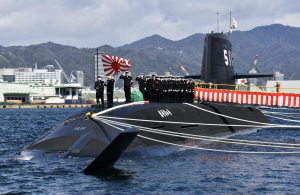The Japan Maritime Self-Defense Force (JMSDF) commissioned its first Soryu-class diesel-electric attack submarine (SSK) equipped with lithium-ion batteries in a ceremony held at the Mitsubishi Heavy Industries (MHI) facility in Kobe, in Hyogo Prefecture in west-central Japan on March 5.
According to a press release by the Japan Maritime Self-Defense Force (JMSDF), the new SSK JS Oryu (with pennant number SS 511) was officially inducted into the JMSDF’s Submarine Flotilla 1, based in Kure, Hiroshima prefecture. Oryu is the 11th SSK of the class to deploy with the JMSDF and the sixth to be built by MHI.
The Oryu, which was launched in October 2018, is equipped with lithium-ion batteries making the JMSDF the only Navy to have installed this technology aboard a submarine. The new batteries will reportedly enable the Oryu to shut off their diesel-electric propulsion and operate on battery power alone for longer periods under water. Batteries are less noisy than diesel-electric engines and consequently reduce the submarine’s acoustic signature making detection harder.
Notably, Soryu-class SSKs are also the first submarines of the JMSDF to be equipped with air-independent propulsion systems, as I explained previously:
The (…) Soryu-class boats are the JMSDF’s first SSKs to be fitted with air-independent propulsion (AIP) systems, enabling the submarines to stay underwater for up to two weeks. (…)
Soryu-class SSKs are powered by two Kawasaki 12V 25/25 SB-type diesel engines and four Kawasaki Kockums V4-275R Stirling AIP engines for silent running. The boats have an estimated range of 6,100 nautical miles (11,297 kilometers) with a maximum surface speed of 13 knots and a subsurface travelling speed of 20 knots. The maximum diving depth of the sub is around 650 meters.
The Soryu-class is fitted with six HU-606 533 mm torpedo tubes that can accommodate Type 89 heavyweight homing torpedoes and UGM-84 Harpoon anti-ship missiles. Next to bow-and-flank-mounted Hughes/Oki ZQQ-7 sonar arrays, the sub is also equipped with a towed array sonar capable of detecting ships over 70 kilometers away.
The Soryu-class has a beam of 9.1 meters and a hull draught of 8.4 meters. Each SSK displaces 2,947 tonnes when surfaced and 4,100 tonnes when submerged. Because of the Soryu-class’ high degree of automation, the each boat’s crew is smaller than on previous JMSDF subs and consists of nine officers and 56 sailors. Additionally, I noted:
The Soryu-class boats’ hydrodynamic design is based on the older Oyashio-class diesel-electric attack submarines currently in service with the JMSDF. It is (…) fitted with a computer-controlled, Swedish-designed X rudder to increase the submarine’s maneuverability when operating in shallow waters close to the seabed.
Kawasaki Heavy Industries (KHI) launched the 12th and final Soryu-class SSK the future JS Toryu (pennant number SS 512), during a ceremony at the company’s shipyard in Kobe in Hyogo Prefecture in November 2019. Like the JS Oryu, the Toryu will also be equipped with lithium-ion batteries. The Toryu is expected to be commissioned in March 2021.

































